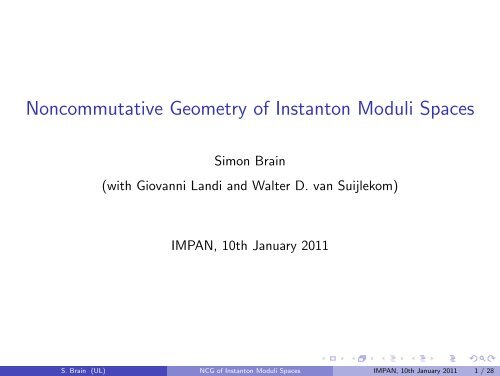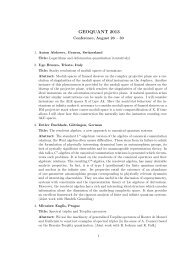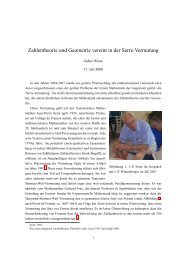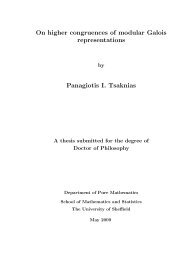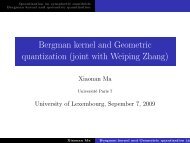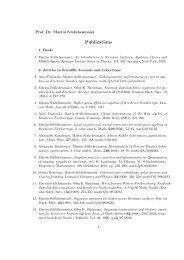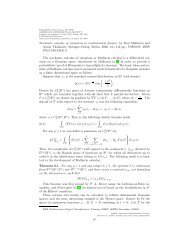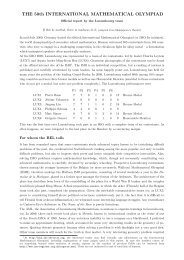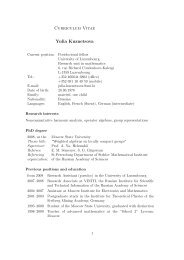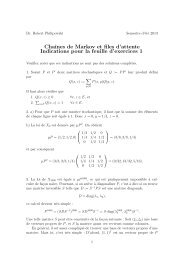Noncommutative Geometry of Instanton Moduli Spaces
Noncommutative Geometry of Instanton Moduli Spaces
Noncommutative Geometry of Instanton Moduli Spaces
Create successful ePaper yourself
Turn your PDF publications into a flip-book with our unique Google optimized e-Paper software.
<strong>Noncommutative</strong> <strong>Geometry</strong> <strong>of</strong> <strong>Instanton</strong> <strong>Moduli</strong> <strong>Spaces</strong><br />
Simon Brain<br />
(with Giovanni Landi and Walter D. van Suijlekom)<br />
IMPAN, 10th January 2011<br />
S. Brain (UL) NCG <strong>of</strong> <strong>Instanton</strong> <strong>Moduli</strong> <strong>Spaces</strong> IMPAN, 10th January 2011 1 / 28
Motivation<br />
What is the difference between a classical four-manifold and a<br />
noncommutative four-manifold?<br />
S. Brain (UL) NCG <strong>of</strong> <strong>Instanton</strong> <strong>Moduli</strong> <strong>Spaces</strong> IMPAN, 10th January 2011 2 / 28
Motivation<br />
What is the difference between a classical four-manifold and a<br />
noncommutative four-manifold?<br />
To find out, we’d like to ‘probe’ their geometric structures somehow.<br />
Donaldson did this for a classical four-manifold M by looking at the moduli<br />
space <strong>of</strong> self-dual gauge fields (instantons) on M. Can we do the same for a<br />
noncommutative manifold?<br />
S. Brain (UL) NCG <strong>of</strong> <strong>Instanton</strong> <strong>Moduli</strong> <strong>Spaces</strong> IMPAN, 10th January 2011 2 / 28
Motivation<br />
What is the difference between a classical four-manifold and a<br />
noncommutative four-manifold?<br />
To find out, we’d like to ‘probe’ their geometric structures somehow.<br />
Donaldson did this for a classical four-manifold M by looking at the moduli<br />
space <strong>of</strong> self-dual gauge fields (instantons) on M. Can we do the same for a<br />
noncommutative manifold?<br />
In this talk, we ask:<br />
◮ how do we construct instantons on a noncommutative manifold?<br />
◮ can we use them to ‘detect’ something about the noncommutative differential<br />
structure?<br />
S. Brain (UL) NCG <strong>of</strong> <strong>Instanton</strong> <strong>Moduli</strong> <strong>Spaces</strong> IMPAN, 10th January 2011 2 / 28
<strong>Instanton</strong>s in Classical <strong>Geometry</strong><br />
Let (M, g) be a compact Riemannian four-manifold.<br />
The Hodge operator ∗ : Ω 2 (M) → Ω 2 (M) obeys ∗ 2 = id and there is an<br />
eigenspace decomposition<br />
Ω 2 (M) = Ω 2 +(M) ⊕ Ω 2 −(M)<br />
into self-dual and anti-self-dual two-forms.<br />
S. Brain (UL) NCG <strong>of</strong> <strong>Instanton</strong> <strong>Moduli</strong> <strong>Spaces</strong> IMPAN, 10th January 2011 3 / 28
<strong>Instanton</strong>s in Classical <strong>Geometry</strong><br />
Let (M, g) be a compact Riemannian four-manifold.<br />
The Hodge operator ∗ : Ω 2 (M) → Ω 2 (M) obeys ∗ 2 = id and there is an<br />
eigenspace decomposition<br />
Ω 2 (M) = Ω 2 +(M) ⊕ Ω 2 −(M)<br />
into self-dual and anti-self-dual two-forms.<br />
Now fix a smooth (S)U(2) vector bundle E over M.<br />
We say that a connection ∇ : Γ(E) → Ω 1 (E) is an instanton if its curvature<br />
F = ∇ 2 is a self-dual two-form, i.e. it obeys ∗F = F .<br />
NB: On M = S 4 , U(2) and SU(2) instantons are ”equivalent” objects.<br />
S. Brain (UL) NCG <strong>of</strong> <strong>Instanton</strong> <strong>Moduli</strong> <strong>Spaces</strong> IMPAN, 10th January 2011 3 / 28
The <strong>Moduli</strong> Space <strong>of</strong> <strong>Instanton</strong>s<br />
The gauge group <strong>of</strong> E is the group<br />
G ⊂ Γ(End(E))<br />
<strong>of</strong> (S)U(2) endomorphisms <strong>of</strong> E which cover the identity on M.<br />
The gauge group G acts on the set C <strong>of</strong> connections on E by<br />
(U, ∇) ↦→ U∇U ∗ , U ∈ G, ∇ ∈ C.<br />
S. Brain (UL) NCG <strong>of</strong> <strong>Instanton</strong> <strong>Moduli</strong> <strong>Spaces</strong> IMPAN, 10th January 2011 4 / 28
The <strong>Moduli</strong> Space <strong>of</strong> <strong>Instanton</strong>s<br />
The gauge group <strong>of</strong> E is the group<br />
G ⊂ Γ(End(E))<br />
<strong>of</strong> (S)U(2) endomorphisms <strong>of</strong> E which cover the identity on M.<br />
The gauge group G acts on the set C <strong>of</strong> connections on E by<br />
(U, ∇) ↦→ U∇U ∗ , U ∈ G, ∇ ∈ C.<br />
The set C/G <strong>of</strong> equivalence classes has the structure <strong>of</strong> an<br />
(infinite-dimensional) Banach manifold.<br />
If non-empty, the submanifold<br />
M := {[∇] ∈ C/G | ∇ is an instanton}<br />
is finite-dimensional (AHS). This is the moduli space <strong>of</strong> instantons on E<br />
S. Brain (UL) NCG <strong>of</strong> <strong>Instanton</strong> <strong>Moduli</strong> <strong>Spaces</strong> IMPAN, 10th January 2011 4 / 28
<strong>Instanton</strong>s on the Euclidean Four-Sphere<br />
For simplicity, we focus on studying instantons on the Euclidean four-sphere S 4 .<br />
Note that (S)U(2) bundles over S 4 (with ch1(E) = 0) are indexed by their<br />
‘topological charge’<br />
k = ch2(E) ∈ H 4 (S 4 , Z).<br />
Let us write Mk for the moduli space <strong>of</strong> instantons on an (S)U(2) vector<br />
bundle E over S 4 with fixed topological charge k ∈ Z.<br />
S. Brain (UL) NCG <strong>of</strong> <strong>Instanton</strong> <strong>Moduli</strong> <strong>Spaces</strong> IMPAN, 10th January 2011 5 / 28
<strong>Instanton</strong>s on the Euclidean Four-Sphere<br />
For simplicity, we focus on studying instantons on the Euclidean four-sphere S 4 .<br />
Note that (S)U(2) bundles over S 4 (with ch1(E) = 0) are indexed by their<br />
‘topological charge’<br />
k = ch2(E) ∈ H 4 (S 4 , Z).<br />
Let us write Mk for the moduli space <strong>of</strong> instantons on an (S)U(2) vector<br />
bundle E over S 4 with fixed topological charge k ∈ Z.<br />
We’re interested in moduli spaces <strong>of</strong> instantons on noncommutative<br />
four-spheres....<br />
....so let’s begin by studying the construction <strong>of</strong> instantons on classical S 4<br />
from the point <strong>of</strong> view <strong>of</strong> noncommutative geometry (i.e. in terms <strong>of</strong><br />
function algebras, projective modules,...).<br />
S. Brain (UL) NCG <strong>of</strong> <strong>Instanton</strong> <strong>Moduli</strong> <strong>Spaces</strong> IMPAN, 10th January 2011 5 / 28
The SU(2) Hopf Fibration<br />
Define A(C 4 ) := A[zi, z ∗ j<br />
Write<br />
| i, j = 1, . . . , 4], then take unit sphere<br />
A(S 7 ) := A[zi, z ∗ j | <br />
Ψ =<br />
z1 z2 z3 z4<br />
−z ∗ 2 z ∗ 1 −z ∗ 4 z ∗ 3<br />
µ z∗ µzµ = 1].<br />
tr<br />
;<br />
then Ψ ∗ Ψ = 2. Define a right action <strong>of</strong> w ∈ SU(2) by Ψ ↦→ Ψw.<br />
S. Brain (UL) NCG <strong>of</strong> <strong>Instanton</strong> <strong>Moduli</strong> <strong>Spaces</strong> IMPAN, 10th January 2011 6 / 28
The SU(2) Hopf Fibration<br />
Define A(C 4 ) := A[zi, z ∗ j<br />
Write<br />
| i, j = 1, . . . , 4], then take unit sphere<br />
A(S 7 ) := A[zi, z ∗ j | <br />
Ψ =<br />
z1 z2 z3 z4<br />
−z ∗ 2 z ∗ 1 −z ∗ 4 z ∗ 3<br />
µ z∗ µzµ = 1].<br />
tr<br />
;<br />
then Ψ ∗ Ψ = 2. Define a right action <strong>of</strong> w ∈ SU(2) by Ψ ↦→ Ψw.<br />
The invariant subalgebra is A(S 4 ) := A[α, α ∗ , β, β ∗ , x | αα ∗ + ββ ∗ + x 2 = 1]<br />
generated by the entries <strong>of</strong> the projection<br />
ΨΨ ∗ = 1<br />
⎛<br />
1 + x<br />
⎜<br />
2 ⎝<br />
0 α −β∗ 0 1 + x β α∗ α∗ β∗ 1 − x<br />
⎞<br />
⎟<br />
0 ⎠<br />
−β α 0 1 − x<br />
Then A(S 4 ) ↩→ A(S 7 ) is a principal SU(2)-bundle.<br />
S. Brain (UL) NCG <strong>of</strong> <strong>Instanton</strong> <strong>Moduli</strong> <strong>Spaces</strong> IMPAN, 10th January 2011 6 / 28
Quaternionic Structure<br />
Note that the A(C 4 )-valued matrix<br />
Ψ =<br />
tr z1 z2 z3 z4<br />
−z ∗ 2 z ∗ 1 −z ∗ 4 z ∗ 3<br />
is made from a pair <strong>of</strong> quaternion-valued functions.<br />
S. Brain (UL) NCG <strong>of</strong> <strong>Instanton</strong> <strong>Moduli</strong> <strong>Spaces</strong> IMPAN, 10th January 2011 7 / 28
Quaternionic Structure<br />
Note that the A(C 4 )-valued matrix<br />
Ψ =<br />
tr z1 z2 z3 z4<br />
−z ∗ 2 z ∗ 1 −z ∗ 4 z ∗ 3<br />
is made from a pair <strong>of</strong> quaternion-valued functions.<br />
This quaternion structure is encoded on A(C4 ) by the ∗-algebra map<br />
J : A(C 4 ) → A(C 4 ), J z1 z2 z3<br />
<br />
∗<br />
z4 = −z2 z∗ 1 −z∗ 4 z∗ <br />
3 .<br />
This gives an identification <strong>of</strong> C 4 with H 2 .<br />
S. Brain (UL) NCG <strong>of</strong> <strong>Instanton</strong> <strong>Moduli</strong> <strong>Spaces</strong> IMPAN, 10th January 2011 7 / 28
Quaternionic Structure<br />
Note that the A(C 4 )-valued matrix<br />
Ψ =<br />
tr z1 z2 z3 z4<br />
−z ∗ 2 z ∗ 1 −z ∗ 4 z ∗ 3<br />
is made from a pair <strong>of</strong> quaternion-valued functions.<br />
This quaternion structure is encoded on A(C4 ) by the ∗-algebra map<br />
J : A(C 4 ) → A(C 4 ), J z1 z2 z3<br />
<br />
∗<br />
z4 = −z2 z∗ 1 −z∗ 4 z∗ <br />
3 .<br />
This gives an identification <strong>of</strong> C 4 with H 2 .<br />
The J-invariant subalgebra <strong>of</strong> A(S 7 ) is precisely A(S 4 ), which is a<br />
coordinate-algebraic interpretation <strong>of</strong> the statement that S 4 HP 1 .<br />
S. Brain (UL) NCG <strong>of</strong> <strong>Instanton</strong> <strong>Moduli</strong> <strong>Spaces</strong> IMPAN, 10th January 2011 7 / 28
Construction <strong>of</strong> <strong>Instanton</strong>s<br />
<strong>Instanton</strong>s on S4 are constructed from monads on C4 , i.e. homomorphisms <strong>of</strong> free<br />
right A(C4 )-modules<br />
H ⊗ A(C 4 ) σz<br />
−→ K ⊗ A(C 4 )<br />
for complex vector spaces H, K <strong>of</strong> dimensions k, 2k + 2, such that:<br />
S. Brain (UL) NCG <strong>of</strong> <strong>Instanton</strong> <strong>Moduli</strong> <strong>Spaces</strong> IMPAN, 10th January 2011 8 / 28
Construction <strong>of</strong> <strong>Instanton</strong>s<br />
<strong>Instanton</strong>s on S4 are constructed from monads on C4 , i.e. homomorphisms <strong>of</strong> free<br />
right A(C4 )-modules<br />
H ⊗ A(C 4 ) σz<br />
−→ K ⊗ A(C 4 )<br />
for complex vector spaces H, K <strong>of</strong> dimensions k, 2k + 2, such that:<br />
σz is linear in the generators z1, . . . , z4 <strong>of</strong> A(C 4 );<br />
S. Brain (UL) NCG <strong>of</strong> <strong>Instanton</strong> <strong>Moduli</strong> <strong>Spaces</strong> IMPAN, 10th January 2011 8 / 28
Construction <strong>of</strong> <strong>Instanton</strong>s<br />
<strong>Instanton</strong>s on S4 are constructed from monads on C4 , i.e. homomorphisms <strong>of</strong> free<br />
right A(C4 )-modules<br />
H ⊗ A(C 4 ) σz<br />
−→ K ⊗ A(C 4 )<br />
for complex vector spaces H, K <strong>of</strong> dimensions k, 2k + 2, such that:<br />
σz is linear in the generators z1, . . . , z4 <strong>of</strong> A(C 4 );<br />
σz is injective and σ ∗ J(z)<br />
is surjective;<br />
S. Brain (UL) NCG <strong>of</strong> <strong>Instanton</strong> <strong>Moduli</strong> <strong>Spaces</strong> IMPAN, 10th January 2011 8 / 28
Construction <strong>of</strong> <strong>Instanton</strong>s<br />
<strong>Instanton</strong>s on S4 are constructed from monads on C4 , i.e. homomorphisms <strong>of</strong> free<br />
right A(C4 )-modules<br />
H ⊗ A(C 4 ) σz<br />
−→ K ⊗ A(C 4 )<br />
for complex vector spaces H, K <strong>of</strong> dimensions k, 2k + 2, such that:<br />
σz is linear in the generators z1, . . . , z4 <strong>of</strong> A(C 4 );<br />
σz is injective and σ∗ J(z)<br />
the composition σ∗ J(z) σz = 0.<br />
is surjective;<br />
S. Brain (UL) NCG <strong>of</strong> <strong>Instanton</strong> <strong>Moduli</strong> <strong>Spaces</strong> IMPAN, 10th January 2011 8 / 28
Construction <strong>of</strong> <strong>Instanton</strong>s<br />
<strong>Instanton</strong>s on S4 are constructed from monads on C4 , i.e. homomorphisms <strong>of</strong> free<br />
right A(C4 )-modules<br />
H ⊗ A(C 4 ) σz<br />
−→ K ⊗ A(C 4 )<br />
for complex vector spaces H, K <strong>of</strong> dimensions k, 2k + 2, such that:<br />
σz is linear in the generators z1, . . . , z4 <strong>of</strong> A(C 4 );<br />
σz is injective and σ∗ J(z)<br />
the composition σ∗ J(z) σz = 0.<br />
is surjective;<br />
Given such a monad, set V := <br />
σz σJ(z) ∈ Mat2k+2,2k(A(C4 )) and then<br />
P := 2k+2 − V (V ∗ V ) −1 V ∗ ∈ Mat2k+2(A(S 4 )).<br />
This P is clearly a projection, P 2 = P ∗ = P .<br />
S. Brain (UL) NCG <strong>of</strong> <strong>Instanton</strong> <strong>Moduli</strong> <strong>Spaces</strong> IMPAN, 10th January 2011 8 / 28
Construction <strong>of</strong> <strong>Instanton</strong>s<br />
<strong>Instanton</strong>s on S4 are constructed from monads on C4 , i.e. homomorphisms <strong>of</strong> free<br />
right A(C4 )-modules<br />
H ⊗ A(C 4 ) σz<br />
−→ K ⊗ A(C 4 )<br />
for complex vector spaces H, K <strong>of</strong> dimensions k, 2k + 2, such that:<br />
σz is linear in the generators z1, . . . , z4 <strong>of</strong> A(C 4 );<br />
σz is injective and σ∗ J(z)<br />
the composition σ∗ J(z) σz = 0.<br />
is surjective;<br />
Given such a monad, set V := <br />
σz σJ(z) ∈ Mat2k+2,2k(A(C4 )) and then<br />
P := 2k+2 − V (V ∗ V ) −1 V ∗ ∈ Mat2k+2(A(S 4 )).<br />
This P is clearly a projection, P 2 = P ∗ = P .<br />
Moreover, E := P A(S 4 ) 2k+2 is a rank two vector bundle over S 4 and<br />
∇ := P ◦ d is an instanton with topological charge k.<br />
S. Brain (UL) NCG <strong>of</strong> <strong>Instanton</strong> <strong>Moduli</strong> <strong>Spaces</strong> IMPAN, 10th January 2011 8 / 28
Gauge Freedom<br />
We say that a pair <strong>of</strong> monads are equivalent if there is a commuting diagram<br />
H ⊗ A(C4 )<br />
⏐<br />
U⊗id<br />
H ⊗ A(C 4 )<br />
σz<br />
−−−−→ K ⊗ A(C4 )<br />
⏐<br />
W ⊗id<br />
˜σz<br />
−−−−→ K ⊗ A(C 4 )<br />
for invertible linear maps U : H → H and W : K → K. The effect on the resulting<br />
projection is to map P ↦→ W P W ∗ .<br />
S. Brain (UL) NCG <strong>of</strong> <strong>Instanton</strong> <strong>Moduli</strong> <strong>Spaces</strong> IMPAN, 10th January 2011 9 / 28
Gauge Freedom<br />
We say that a pair <strong>of</strong> monads are equivalent if there is a commuting diagram<br />
H ⊗ A(C4 )<br />
⏐<br />
U⊗id<br />
H ⊗ A(C 4 )<br />
σz<br />
−−−−→ K ⊗ A(C4 )<br />
⏐<br />
W ⊗id<br />
˜σz<br />
−−−−→ K ⊗ A(C 4 )<br />
for invertible linear maps U : H → H and W : K → K. The effect on the resulting<br />
projection is to map P ↦→ W P W ∗ .<br />
Theorem (ADHM) There is a bijective correspondence<br />
Mk ∼ = {Monads with index k}/ ∼ .<br />
So these equivalences <strong>of</strong> monads account for all <strong>of</strong> the gauge freedom in the<br />
construction <strong>of</strong> instantons.<br />
S. Brain (UL) NCG <strong>of</strong> <strong>Instanton</strong> <strong>Moduli</strong> <strong>Spaces</strong> IMPAN, 10th January 2011 9 / 28
The Space <strong>of</strong> Monads<br />
Note that, since σz : H ⊗ A(C 4 ) → K ⊗ A(C 4 ) is linear in the generators<br />
z1, . . . , z4, it can be written<br />
σz =<br />
4<br />
j=1<br />
M j<br />
ab ⊗ zj, σ ∗ z =<br />
4<br />
j=1<br />
for constant matrices M j ∈ Mat2k+2,k(C), j = 1, . . . , 4.<br />
M j ∗ ∗<br />
ab ⊗ zj ,<br />
S. Brain (UL) NCG <strong>of</strong> <strong>Instanton</strong> <strong>Moduli</strong> <strong>Spaces</strong> IMPAN, 10th January 2011 10 / 28
The Space <strong>of</strong> Monads<br />
Note that, since σz : H ⊗ A(C 4 ) → K ⊗ A(C 4 ) is linear in the generators<br />
z1, . . . , z4, it can be written<br />
σz =<br />
4<br />
j=1<br />
M j<br />
ab ⊗ zj, σ ∗ z =<br />
4<br />
j=1<br />
for constant matrices M j ∈ Mat2k+2,k(C), j = 1, . . . , 4.<br />
M j ∗ ∗<br />
ab ⊗ zj ,<br />
As we allow σz to vary, we can think <strong>of</strong> the matrix elements M j j<br />
ab , M<br />
coordinate functions on the space <strong>of</strong> all monads with index k.<br />
ab ∗ as<br />
S. Brain (UL) NCG <strong>of</strong> <strong>Instanton</strong> <strong>Moduli</strong> <strong>Spaces</strong> IMPAN, 10th January 2011 10 / 28
The Space <strong>of</strong> Monads<br />
Note that, since σz : H ⊗ A(C 4 ) → K ⊗ A(C 4 ) is linear in the generators<br />
z1, . . . , z4, it can be written<br />
σz =<br />
4<br />
j=1<br />
M j<br />
ab ⊗ zj, σ ∗ z =<br />
4<br />
j=1<br />
for constant matrices M j ∈ Mat2k+2,k(C), j = 1, . . . , 4.<br />
M j ∗ ∗<br />
ab ⊗ zj ,<br />
As we allow σz to vary, we can think <strong>of</strong> the matrix elements M j j<br />
, M<br />
coordinate functions on the space <strong>of</strong> all monads with index k.<br />
The monad condition σ ∗ J(z) σz = 0 translates into the relations<br />
<br />
for all j, l = 1, . . . , 4 and c, d = 1, . . . , k, where<br />
b<br />
ab<br />
ab ∗ as<br />
<br />
N j<br />
abM l bd + N l abM j<br />
<br />
bd = 0, (1)<br />
σ ∗ J(z) = N j ⊗ zj = M j ∗ ⊗ J(zj) ∗ .<br />
S. Brain (UL) NCG <strong>of</strong> <strong>Instanton</strong> <strong>Moduli</strong> <strong>Spaces</strong> IMPAN, 10th January 2011 10 / 28
The Space <strong>of</strong> Monads<br />
Note that, since σz : H ⊗ A(C 4 ) → K ⊗ A(C 4 ) is linear in the generators<br />
z1, . . . , z4, it can be written<br />
σz =<br />
4<br />
j=1<br />
M j<br />
ab ⊗ zj, σ ∗ z =<br />
4<br />
j=1<br />
for constant matrices M j ∈ Mat2k+2,k(C), j = 1, . . . , 4.<br />
M j ∗ ∗<br />
ab ⊗ zj ,<br />
As we allow σz to vary, we can think <strong>of</strong> the matrix elements M j j<br />
, M<br />
coordinate functions on the space <strong>of</strong> all monads with index k.<br />
The monad condition σ ∗ J(z) σz = 0 translates into the relations<br />
<br />
for all j, l = 1, . . . , 4 and c, d = 1, . . . , k, where<br />
b<br />
ab<br />
ab ∗ as<br />
<br />
N j<br />
abM l bd + N l abM j<br />
<br />
bd = 0, (1)<br />
σ ∗ J(z) = N j ⊗ zj = M j ∗ ⊗ J(zj) ∗ .<br />
We write A(Mk) for the algebra generated by the functions M j j<br />
ab , M<br />
modulo the relations (1).<br />
S. Brain (UL) NCG <strong>of</strong> <strong>Instanton</strong> <strong>Moduli</strong> <strong>Spaces</strong> IMPAN, 10th January 2011 10 / 28<br />
ab ∗ ,
Functorial Cocycle Deformation<br />
Now we pass to noncommutative geometry. We view the deformation as a functor<br />
LF : H C → HF C<br />
from a certain category H C (wherein lives our classical geometry) to a new<br />
category HF C, both to be determined.<br />
S. Brain (UL) NCG <strong>of</strong> <strong>Instanton</strong> <strong>Moduli</strong> <strong>Spaces</strong> IMPAN, 10th January 2011 11 / 28
Functorial Cocycle Deformation<br />
Now we pass to noncommutative geometry. We view the deformation as a functor<br />
LF : H C → HF C<br />
from a certain category H C (wherein lives our classical geometry) to a new<br />
category HF C, both to be determined.<br />
Let H be a commutative unital Hopf algebra. Let F : H ⊗ H → C be a<br />
convolution-invertible unital two-cocycle on H.<br />
S. Brain (UL) NCG <strong>of</strong> <strong>Instanton</strong> <strong>Moduli</strong> <strong>Spaces</strong> IMPAN, 10th January 2011 11 / 28
Functorial Cocycle Deformation<br />
Now we pass to noncommutative geometry. We view the deformation as a functor<br />
LF : H C → HF C<br />
from a certain category H C (wherein lives our classical geometry) to a new<br />
category HF C, both to be determined.<br />
Let H be a commutative unital Hopf algebra. Let F : H ⊗ H → C be a<br />
convolution-invertible unital two-cocycle on H.<br />
Then there is a new Hopf algebra HF which is the same as H as a coalgebra,<br />
but has the new product<br />
h •F g := F (h (1), g (1))h (2)g (2)F −1 (h (3), g (3)).<br />
S. Brain (UL) NCG <strong>of</strong> <strong>Instanton</strong> <strong>Moduli</strong> <strong>Spaces</strong> IMPAN, 10th January 2011 11 / 28
Functorial Cocycle Deformation<br />
Now we pass to noncommutative geometry. We view the deformation as a functor<br />
LF : H C → HF C<br />
from a certain category H C (wherein lives our classical geometry) to a new<br />
category HF C, both to be determined.<br />
Let H be a commutative unital Hopf algebra. Let F : H ⊗ H → C be a<br />
convolution-invertible unital two-cocycle on H.<br />
Then there is a new Hopf algebra HF which is the same as H as a coalgebra,<br />
but has the new product<br />
h •F g := F (h (1), g (1))h (2)g (2)F −1 (h (3), g (3)).<br />
In fact, since H = HF as a coalgebra, H-comodules are exactly the same<br />
thing as HF -comodules.<br />
So there is an invertible functor LF : H C → HF C which simultaneously<br />
converts all H-covariant constructions into HF -covariant ones (it’s just the<br />
identity functor).<br />
S. Brain (UL) NCG <strong>of</strong> <strong>Instanton</strong> <strong>Moduli</strong> <strong>Spaces</strong> IMPAN, 10th January 2011 11 / 28
The Deformation Functor<br />
More interesting is the fact that the trivial braiding on H C,<br />
Ψ : A ⊗ B → B ⊗ A, Ψ(a ⊗ b) = b ⊗ a,<br />
is twisted into a new braiding on HF C,<br />
ΨF : AF ⊗ BF → BF ⊗ AF , ΨF (a ⊗ b) = F −2 (b (−1) , a (−1) )b (0) ⊗ a (0) .<br />
If A is a left H-comodule algebra,<br />
∆L : A → H ⊗ A, ∆(a) = a (−1) ⊗ a (0) ,<br />
then the algebra AF := LF (A) with product a ·F b := F (a (−1) , b (−1) )a (0) b (0)<br />
is a left HF -comodule algebra.<br />
S. Brain (UL) NCG <strong>of</strong> <strong>Instanton</strong> <strong>Moduli</strong> <strong>Spaces</strong> IMPAN, 10th January 2011 12 / 28
The Deformation Functor<br />
More interesting is the fact that the trivial braiding on H C,<br />
Ψ : A ⊗ B → B ⊗ A, Ψ(a ⊗ b) = b ⊗ a,<br />
is twisted into a new braiding on HF C,<br />
ΨF : AF ⊗ BF → BF ⊗ AF , ΨF (a ⊗ b) = F −2 (b (−1) , a (−1) )b (0) ⊗ a (0) .<br />
If A is a left H-comodule algebra,<br />
∆L : A → H ⊗ A, ∆(a) = a (−1) ⊗ a (0) ,<br />
then the algebra AF := LF (A) with product a ·F b := F (a (−1) , b (−1) )a (0) b (0)<br />
is a left HF -comodule algebra.<br />
Theorem (Majid-Oeckl) The functor LF : H C → HF C is an isomorphism <strong>of</strong><br />
braided monoidal categories.<br />
S. Brain (UL) NCG <strong>of</strong> <strong>Instanton</strong> <strong>Moduli</strong> <strong>Spaces</strong> IMPAN, 10th January 2011 12 / 28
Example: Twisting by a Torus Action<br />
Take H = A(T 2 ), generated by t1, t2 with tjt ∗ j = t∗ j tj = 1,<br />
∆(tj) = tj ⊗ tj, S(tj) = t ∗ j , ɛ(tj) = 1.<br />
S. Brain (UL) NCG <strong>of</strong> <strong>Instanton</strong> <strong>Moduli</strong> <strong>Spaces</strong> IMPAN, 10th January 2011 13 / 28
Example: Twisting by a Torus Action<br />
Take H = A(T 2 ), generated by t1, t2 with tjt ∗ j = t∗ j tj = 1,<br />
Define a cocycle by<br />
∆(tj) = tj ⊗ tj, S(tj) = t ∗ j , ɛ(tj) = 1.<br />
F (ti, ti) = 1, F (t1, t2) := exp( 1<br />
2 iπθ),<br />
extended as a Hopf bicharacter. Then H = HF as a Hopf algebra, but the<br />
category <strong>of</strong> H-comodules is twisted.<br />
S. Brain (UL) NCG <strong>of</strong> <strong>Instanton</strong> <strong>Moduli</strong> <strong>Spaces</strong> IMPAN, 10th January 2011 13 / 28
Example: Twisting by a Torus Action<br />
Take H = A(T 2 ), generated by t1, t2 with tjt ∗ j = t∗ j tj = 1,<br />
Define a cocycle by<br />
∆(tj) = tj ⊗ tj, S(tj) = t ∗ j , ɛ(tj) = 1.<br />
F (ti, ti) = 1, F (t1, t2) := exp( 1<br />
2 iπθ),<br />
extended as a Hopf bicharacter. Then H = HF as a Hopf algebra, but the<br />
category <strong>of</strong> H-comodules is twisted.<br />
Example: The coproduct ∆ : H → H ⊗ H makes H into an H-comodule algebra<br />
in the category H C. The comodule-twisted torus has algebra relations<br />
t1 ·F t2 = F (t1, t2)t1t2 = F 2 (t1, t2)t2 ·F t1 = µt2 ·F t1, µ = exp(iπθ)<br />
i.e. we get the noncommutative torus A(T 2 θ ) as an algebra in HF C.<br />
S. Brain (UL) NCG <strong>of</strong> <strong>Instanton</strong> <strong>Moduli</strong> <strong>Spaces</strong> IMPAN, 10th January 2011 13 / 28
Example: The Connes-Landi Sphere<br />
Similarly, we have a coaction<br />
A(C 4 ) → H ⊗ A(C 4 ), zj ↦→ τj ⊗ zj, (τj) := (t1, t ∗ 1, t2, t ∗ 2).<br />
This gives twisted algebras A(C 4 θ ), A(S7 θ ), generated by zj, z ∗ l<br />
zjzl = ηljzlzj,<br />
zjz ∗ l = ηjlz ∗ l zj,<br />
⎛<br />
1<br />
⎜<br />
where (ηjl) = ⎜1<br />
⎝µ<br />
1<br />
1<br />
¯µ<br />
¯µ<br />
µ<br />
1<br />
⎞<br />
µ<br />
¯µ ⎟<br />
1⎠<br />
,<br />
subject to<br />
µ := exp (iπθ).<br />
¯µ µ 1 1<br />
S. Brain (UL) NCG <strong>of</strong> <strong>Instanton</strong> <strong>Moduli</strong> <strong>Spaces</strong> IMPAN, 10th January 2011 14 / 28
Example: The Connes-Landi Sphere<br />
Similarly, we have a coaction<br />
A(C 4 ) → H ⊗ A(C 4 ), zj ↦→ τj ⊗ zj, (τj) := (t1, t ∗ 1, t2, t ∗ 2).<br />
This gives twisted algebras A(C 4 θ ), A(S7 θ ), generated by zj, z ∗ l<br />
zjzl = ηljzlzj,<br />
zjz ∗ l = ηjlz ∗ l zj,<br />
⎛<br />
1<br />
⎜<br />
where (ηjl) = ⎜1<br />
⎝µ<br />
1<br />
1<br />
¯µ<br />
¯µ<br />
µ<br />
1<br />
⎞<br />
µ<br />
¯µ ⎟<br />
1⎠<br />
,<br />
subject to<br />
µ := exp (iπθ).<br />
¯µ µ 1 1<br />
The SU(2)-invariant subalgebra A(S4 θ ) generated by entries <strong>of</strong> the projection<br />
ΨΨ ∗ = 1<br />
2<br />
⎛<br />
1 + x 0 α −¯µ β<br />
⎜<br />
⎝<br />
∗<br />
⎞<br />
⎟<br />
⎠ .<br />
0 1 + x β µ α ∗<br />
α ∗ β ∗ 1 − x 0<br />
−µ β ¯µ α 0 1 − x<br />
The inclusion A(S4 θ ) ↩→ A(S7 θ ) is a noncommutative principal SU(2)-bundle.<br />
S. Brain (UL) NCG <strong>of</strong> <strong>Instanton</strong> <strong>Moduli</strong> <strong>Spaces</strong> IMPAN, 10th January 2011 14 / 28
Differential and Hodge Structure on S 4 θ<br />
The coaction A(S 4 ) → H ⊗ A(S 4 ) is by isometries, i.e. it is an intertwiner<br />
for the exterior derivative d : A(S 4 ) → Ω 1 (S 4 ).<br />
This means that the differential calculus Ω • (S 4 ) is also an object in H C. So<br />
we can deform it to get a differential calculus Ω • (S 4 θ ) on S4 θ .<br />
S. Brain (UL) NCG <strong>of</strong> <strong>Instanton</strong> <strong>Moduli</strong> <strong>Spaces</strong> IMPAN, 10th January 2011 15 / 28
Differential and Hodge Structure on S 4 θ<br />
The coaction A(S 4 ) → H ⊗ A(S 4 ) is by isometries, i.e. it is an intertwiner<br />
for the exterior derivative d : A(S 4 ) → Ω 1 (S 4 ).<br />
This means that the differential calculus Ω • (S 4 ) is also an object in H C. So<br />
we can deform it to get a differential calculus Ω • (S 4 θ ) on S4 θ .<br />
Similarly, the Hodge operator ∗ : Ω 2 (S 4 ) → Ω 2 (S 4 ) is H-equivariant and so<br />
it is a morphism in H C. Similarly for the map J : A(C 4 ) → A(C 4 ). Their<br />
images under LF are a Hodge operator and a quaternion structure<br />
∗θ : Ω 2 (S 4 θ ) → Ω 2 (S 4 θ ), J : A(C 4 θ) → A(C 4 θ).<br />
S. Brain (UL) NCG <strong>of</strong> <strong>Instanton</strong> <strong>Moduli</strong> <strong>Spaces</strong> IMPAN, 10th January 2011 15 / 28
Differential and Hodge Structure on S 4 θ<br />
The coaction A(S 4 ) → H ⊗ A(S 4 ) is by isometries, i.e. it is an intertwiner<br />
for the exterior derivative d : A(S 4 ) → Ω 1 (S 4 ).<br />
This means that the differential calculus Ω • (S 4 ) is also an object in H C. So<br />
we can deform it to get a differential calculus Ω • (S 4 θ ) on S4 θ .<br />
Similarly, the Hodge operator ∗ : Ω 2 (S 4 ) → Ω 2 (S 4 ) is H-equivariant and so<br />
it is a morphism in H C. Similarly for the map J : A(C 4 ) → A(C 4 ). Their<br />
images under LF are a Hodge operator and a quaternion structure<br />
∗θ : Ω 2 (S 4 θ ) → Ω 2 (S 4 θ ), J : A(C 4 θ) → A(C 4 θ).<br />
This is all we need to discuss instantons on S 4 θ .<br />
S. Brain (UL) NCG <strong>of</strong> <strong>Instanton</strong> <strong>Moduli</strong> <strong>Spaces</strong> IMPAN, 10th January 2011 15 / 28
Differential and Hodge Structure on S 4 θ<br />
The coaction A(S 4 ) → H ⊗ A(S 4 ) is by isometries, i.e. it is an intertwiner<br />
for the exterior derivative d : A(S 4 ) → Ω 1 (S 4 ).<br />
This means that the differential calculus Ω • (S 4 ) is also an object in H C. So<br />
we can deform it to get a differential calculus Ω • (S 4 θ ) on S4 θ .<br />
Similarly, the Hodge operator ∗ : Ω 2 (S 4 ) → Ω 2 (S 4 ) is H-equivariant and so<br />
it is a morphism in H C. Similarly for the map J : A(C 4 ) → A(C 4 ). Their<br />
images under LF are a Hodge operator and a quaternion structure<br />
∗θ : Ω 2 (S 4 θ ) → Ω 2 (S 4 θ ), J : A(C 4 θ) → A(C 4 θ).<br />
This is all we need to discuss instantons on S 4 θ .<br />
Remark: In fact this works for the action <strong>of</strong> any locally compact Abelian group -<br />
so all <strong>of</strong> the following works in particular for the Moyal plane R4 as well.<br />
Can we use this to find a construction <strong>of</strong> instantons on S 4 θ ?<br />
S. Brain (UL) NCG <strong>of</strong> <strong>Instanton</strong> <strong>Moduli</strong> <strong>Spaces</strong> IMPAN, 10th January 2011 15 / 28
A <strong>Noncommutative</strong> Family <strong>of</strong> Monads over C 4 θ<br />
The map<br />
σz : H ⊗ A(C 4 ) → A(Mk) ⊗ K ⊗ A(C 4 ), σz = <br />
is a morphism in H M provided A(Mk) carries the H-coaction<br />
A(Mk) → H ⊗ A(Mk), M j<br />
ab ↦→ τ ∗ j ⊗ M j<br />
ab .<br />
j<br />
j<br />
Mab ⊗ zj<br />
S. Brain (UL) NCG <strong>of</strong> <strong>Instanton</strong> <strong>Moduli</strong> <strong>Spaces</strong> IMPAN, 10th January 2011 16 / 28
A <strong>Noncommutative</strong> Family <strong>of</strong> Monads over C 4 θ<br />
The map<br />
σz : H ⊗ A(C 4 ) → A(Mk) ⊗ K ⊗ A(C 4 ), σz = <br />
is a morphism in H M provided A(Mk) carries the H-coaction<br />
A(Mk) → H ⊗ A(Mk), M j<br />
ab ↦→ τ ∗ j ⊗ M j<br />
ab .<br />
j<br />
j<br />
Mab ⊗ zj<br />
Under the deformation functor, we get a new algebra A(Mk,θ) generated by<br />
j<br />
, M<br />
the matrix elements M j<br />
ab<br />
ab ∗ , but now subject to the twisted relations<br />
M j<br />
ab M l cd = ηljM l cdM j<br />
ab .<br />
S. Brain (UL) NCG <strong>of</strong> <strong>Instanton</strong> <strong>Moduli</strong> <strong>Spaces</strong> IMPAN, 10th January 2011 16 / 28
A <strong>Noncommutative</strong> Family <strong>of</strong> Monads over C 4 θ<br />
The map<br />
σz : H ⊗ A(C 4 ) → A(Mk) ⊗ K ⊗ A(C 4 ), σz = <br />
is a morphism in H M provided A(Mk) carries the H-coaction<br />
A(Mk) → H ⊗ A(Mk), M j<br />
ab ↦→ τ ∗ j ⊗ M j<br />
ab .<br />
j<br />
j<br />
Mab ⊗ zj<br />
Under the deformation functor, we get a new algebra A(Mk,θ) generated by<br />
j<br />
, M<br />
the matrix elements M j<br />
ab<br />
ab ∗ , but now subject to the twisted relations<br />
M j<br />
ab M l cd = ηljM l cdM j<br />
ab .<br />
We interpret the underlying ‘space’ Mk,θ as parameterising a<br />
noncommutative family <strong>of</strong> monads over C4 θ with index k.<br />
S. Brain (UL) NCG <strong>of</strong> <strong>Instanton</strong> <strong>Moduli</strong> <strong>Spaces</strong> IMPAN, 10th January 2011 16 / 28
The <strong>Noncommutative</strong> ADHM Construction<br />
Although the space Mk,θ has fewer classical points than Mk, we can nevertheless<br />
work with the whole noncommutative family <strong>of</strong> monads at once.<br />
The algebra-valued matrix σz = <br />
j M j ⊗ zj is now thought <strong>of</strong> as a map<br />
σz : H ⊗ A(C 4 θ) → A(Mk,θ) ⊗ K ⊗ A(C 4 θ).<br />
S. Brain (UL) NCG <strong>of</strong> <strong>Instanton</strong> <strong>Moduli</strong> <strong>Spaces</strong> IMPAN, 10th January 2011 17 / 28
The <strong>Noncommutative</strong> ADHM Construction<br />
Although the space Mk,θ has fewer classical points than Mk, we can nevertheless<br />
work with the whole noncommutative family <strong>of</strong> monads at once.<br />
The algebra-valued matrix σz = <br />
j M j ⊗ zj is now thought <strong>of</strong> as a map<br />
σz : H ⊗ A(C 4 θ) → A(Mk,θ) ⊗ K ⊗ A(C 4 θ).<br />
For each character ɛ : A(Mk,θ) → C (i.e. for each classical point <strong>of</strong> Mk,θ)<br />
there is a corresponding monad<br />
(ɛ ⊗ id) ◦ σz : H ⊗ A(C 4 θ) → K ⊗ A(C 4 θ).<br />
S. Brain (UL) NCG <strong>of</strong> <strong>Instanton</strong> <strong>Moduli</strong> <strong>Spaces</strong> IMPAN, 10th January 2011 17 / 28
The <strong>Noncommutative</strong> ADHM Construction<br />
Although the space Mk,θ has fewer classical points than Mk, we can nevertheless<br />
work with the whole noncommutative family <strong>of</strong> monads at once.<br />
The algebra-valued matrix σz = <br />
j M j ⊗ zj is now thought <strong>of</strong> as a map<br />
σz : H ⊗ A(C 4 θ) → A(Mk,θ) ⊗ K ⊗ A(C 4 θ).<br />
For each character ɛ : A(Mk,θ) → C (i.e. for each classical point <strong>of</strong> Mk,θ)<br />
there is a corresponding monad<br />
(ɛ ⊗ id) ◦ σz : H ⊗ A(C 4 θ) → K ⊗ A(C 4 θ).<br />
The ADHM construction goes through just as before. This time take<br />
<br />
∈ Mat2k+2,2k(A(Mk,θ) ⊗ A(C 4 θ)).<br />
V := σz σ ∗ z<br />
Then set P := 2k+2 − V (V ∗ V ) −1 V ∗ ∈ Mat2k+2(A(Mk,θ) ⊗ A(S 4 θ )).<br />
S. Brain (UL) NCG <strong>of</strong> <strong>Instanton</strong> <strong>Moduli</strong> <strong>Spaces</strong> IMPAN, 10th January 2011 17 / 28
A <strong>Noncommutative</strong> Family <strong>of</strong> <strong>Instanton</strong>s<br />
From this family <strong>of</strong> projections P parameterised by the space Mk,θ we obtain a<br />
noncommutative family <strong>of</strong> instantons.<br />
Theorem (SB-GL) (Generalises k = 1 case <strong>of</strong> Landi-Pagani-Reina-van Suijlekom)<br />
The finitely generated projective right A(Mk,θ) ⊗ A(S 4 θ )-module<br />
E := P A(Mk,θ) ⊗ A(S 4 θ ) 2k+2<br />
is a noncommutative family <strong>of</strong> rank two vector bundles over S 4 θ ,<br />
parameterised by the noncommutative space Mk,θ.<br />
S. Brain (UL) NCG <strong>of</strong> <strong>Instanton</strong> <strong>Moduli</strong> <strong>Spaces</strong> IMPAN, 10th January 2011 18 / 28
A <strong>Noncommutative</strong> Family <strong>of</strong> <strong>Instanton</strong>s<br />
From this family <strong>of</strong> projections P parameterised by the space Mk,θ we obtain a<br />
noncommutative family <strong>of</strong> instantons.<br />
Theorem (SB-GL) (Generalises k = 1 case <strong>of</strong> Landi-Pagani-Reina-van Suijlekom)<br />
The finitely generated projective right A(Mk,θ) ⊗ A(S 4 θ )-module<br />
E := P A(Mk,θ) ⊗ A(S 4 θ ) 2k+2<br />
is a noncommutative family <strong>of</strong> rank two vector bundles over S 4 θ ,<br />
parameterised by the noncommutative space Mk,θ.<br />
The operator ∇ := P ◦ (id ⊗ d) is a noncommutative family <strong>of</strong> instantons<br />
with topological charge k, parameterised by the noncommutative space Mk,θ.<br />
The latter statement means that the curvature F = ∇ 2 <strong>of</strong> the family obeys<br />
(id ⊗ ∗θ)F = F,<br />
where ∗θ : Ω 2 (S 4 θ ) → Ω2 (S 4 θ ) is the Hodge operator on S4 θ .<br />
S. Brain (UL) NCG <strong>of</strong> <strong>Instanton</strong> <strong>Moduli</strong> <strong>Spaces</strong> IMPAN, 10th January 2011 18 / 28
Gauge Freedom in the <strong>Noncommutative</strong> Case<br />
Even though the map<br />
σz : H ⊗ A(C 4 θ) → A(Mk,θ) ⊗ K ⊗ A(C 4 θ)<br />
is a noncommutative family <strong>of</strong> module homomorphisms, we still have the<br />
freedom to change bases in the vector spaces H and K. This is the same<br />
gauge freedom that we had in the classical case.<br />
S. Brain (UL) NCG <strong>of</strong> <strong>Instanton</strong> <strong>Moduli</strong> <strong>Spaces</strong> IMPAN, 10th January 2011 19 / 28
Gauge Freedom in the <strong>Noncommutative</strong> Case<br />
Even though the map<br />
σz : H ⊗ A(C 4 θ) → A(Mk,θ) ⊗ K ⊗ A(C 4 θ)<br />
is a noncommutative family <strong>of</strong> module homomorphisms, we still have the<br />
freedom to change bases in the vector spaces H and K. This is the same<br />
gauge freedom that we had in the classical case.<br />
However, we now have more gauge freedom. The deformation functor<br />
canonically equips A(Mk,θ) with a Z 2 -action defined by<br />
(m1, m2) ⊲ a = F −2 (a (−1) , t m1<br />
1 tm2<br />
2 ) a(0) , (m1, m2) ∈ Z 2 , a ∈ A(Mk,θ).<br />
This action becomes trivial in the classical limit.<br />
This action is by gauge transformations (i.e. it generates projections which<br />
are unitarily equivalent to P ).<br />
S. Brain (UL) NCG <strong>of</strong> <strong>Instanton</strong> <strong>Moduli</strong> <strong>Spaces</strong> IMPAN, 10th January 2011 19 / 28
Gauge Freedom in the <strong>Noncommutative</strong> Case<br />
Even though the map<br />
σz : H ⊗ A(C 4 θ) → A(Mk,θ) ⊗ K ⊗ A(C 4 θ)<br />
is a noncommutative family <strong>of</strong> module homomorphisms, we still have the<br />
freedom to change bases in the vector spaces H and K. This is the same<br />
gauge freedom that we had in the classical case.<br />
However, we now have more gauge freedom. The deformation functor<br />
canonically equips A(Mk,θ) with a Z 2 -action defined by<br />
(m1, m2) ⊲ a = F −2 (a (−1) , t m1<br />
1 tm2<br />
2 ) a(0) , (m1, m2) ∈ Z 2 , a ∈ A(Mk,θ).<br />
This action becomes trivial in the classical limit.<br />
This action is by gauge transformations (i.e. it generates projections which<br />
are unitarily equivalent to P ).<br />
Thus the correct (?) parameter space for the construction is the quotient <strong>of</strong><br />
the space Mk,θ by Z 2 , described by the crossed product A(Mk,θ)>⊳ Z 2 .<br />
S. Brain (UL) NCG <strong>of</strong> <strong>Instanton</strong> <strong>Moduli</strong> <strong>Spaces</strong> IMPAN, 10th January 2011 19 / 28
Bosonisation<br />
There is another way to arrive at this crossed product algebra.<br />
The construction <strong>of</strong> instantons and, in particular, the parameter algebra<br />
A(Mk,θ) live in the braided tensor category HF C.<br />
To get back to the category <strong>of</strong> vector spaces, we apply Majid’s ‘bosonisation’<br />
construction, which just means taking the smash product with HF = A(T 2 ),<br />
yielding the algebra A(Mk,θ)>⊳ A(T 2 ).<br />
Now applying the Fourier transform on T 2 gives an isomorphism<br />
since Z 2 is the Pontryagin dual <strong>of</strong> T 2 .<br />
A(Mk,θ)>⊳A(T 2 ) → A(Mk,θ)>⊳ Z 2 ,<br />
S. Brain (UL) NCG <strong>of</strong> <strong>Instanton</strong> <strong>Moduli</strong> <strong>Spaces</strong> IMPAN, 10th January 2011 20 / 28
Understanding the <strong>Noncommutative</strong> Parameter <strong>Spaces</strong><br />
How can we make sense <strong>of</strong> these noncommutative parameter spaces?<br />
S. Brain (UL) NCG <strong>of</strong> <strong>Instanton</strong> <strong>Moduli</strong> <strong>Spaces</strong> IMPAN, 10th January 2011 21 / 28
Understanding the <strong>Noncommutative</strong> Parameter <strong>Spaces</strong><br />
How can we make sense <strong>of</strong> these noncommutative parameter spaces?<br />
Theorem (SB-GL-WvS)<br />
The algebra A(Mk,θ)>⊳ Z 2 has a commutative subalgebra, denoted A(Mk).<br />
There is a canonical action <strong>of</strong> Z 2 on A(Mk) by gauge transformations<br />
There is an isomorphism<br />
A(Mk,θ)>⊳ Z 2 A(Mk)>⊳ ′ Z 2 .<br />
S. Brain (UL) NCG <strong>of</strong> <strong>Instanton</strong> <strong>Moduli</strong> <strong>Spaces</strong> IMPAN, 10th January 2011 21 / 28
Understanding the <strong>Noncommutative</strong> Parameter <strong>Spaces</strong><br />
How can we make sense <strong>of</strong> these noncommutative parameter spaces?<br />
Theorem (SB-GL-WvS)<br />
The algebra A(Mk,θ)>⊳ Z 2 has a commutative subalgebra, denoted A(Mk).<br />
There is a canonical action <strong>of</strong> Z 2 on A(Mk) by gauge transformations<br />
There is an isomorphism<br />
A(Mk,θ)>⊳ Z 2 A(Mk)>⊳ ′ Z 2 .<br />
The algebra A(Mk) is the (commutative) coordinate algebra <strong>of</strong> a space Mk <strong>of</strong><br />
bona fide monads on C 4 θ , i.e. homomorphisms <strong>of</strong> free A(C4 θ )-modules<br />
H ⊗ A(C 4 θ) σz<br />
−→ K ⊗ A(C 4 θ)<br />
for complex vector spaces H, K <strong>of</strong> dimensions k, 2k + 2.<br />
S. Brain (UL) NCG <strong>of</strong> <strong>Instanton</strong> <strong>Moduli</strong> <strong>Spaces</strong> IMPAN, 10th January 2011 21 / 28
The <strong>Noncommutative</strong> ADHM Equations<br />
Now that we have discovered a classical space <strong>of</strong> instantons, we can describe it<br />
more explicity.<br />
Theorem (SB-WvS) The space Mk/ ∼ <strong>of</strong> equivalence classes <strong>of</strong> monads on C 4 θ is<br />
given by the set <strong>of</strong> matrices<br />
satisfying the equations<br />
B1, B2 ∈ Matk(C), I ∈ Mat2,k(C), J ∈ Matk,2(C)<br />
¯µB1B2 − µB2B1 + IJ = 0,<br />
[B1, B ∗ 1] + [B2, B ∗ 2] + II ∗ − J ∗ J = 0<br />
(where µ = exp(iπθ)), modulo the action <strong>of</strong> g ∈ U(k) given by Bj ↦→ gBjg −1 ,<br />
I ↦→ gI, J ↦→ Jg −1 .<br />
The classical limit recovers the ordinary ADHM equations on classical S 4 .<br />
S. Brain (UL) NCG <strong>of</strong> <strong>Instanton</strong> <strong>Moduli</strong> <strong>Spaces</strong> IMPAN, 10th January 2011 22 / 28
The Moyal-Groenewold Plane R 4 <br />
If we work in a local patch R4 <strong>of</strong> S4 and twist by the group <strong>of</strong> translation<br />
symmetries, we get the Moyal plane A(R4 ). The twisting Hopf algebra is<br />
H = A(R4 ).<br />
The deformation is again functorial, so we get a noncommutative family <strong>of</strong><br />
monads A(Mk,) on the deformed space C 4 .<br />
This time there is a canonical action <strong>of</strong> R 4 by gauge A(Mk,) by gauge<br />
transformations, so we obtain the cross product A(Mk,)>⊳ R 4 .<br />
We can also get this by bosonisation and Fourier transform,<br />
A(Mk,)>⊳A(R 4 ) → A(Mk,)>⊳ R 4 .<br />
Again we recover a classical space <strong>of</strong> monads; the resulting ADHM equations are<br />
those <strong>of</strong> Nekrasov-Schwarz:<br />
[B1, B2] + IJ = 0,<br />
[B1, B ∗ 1] + [B2, B ∗ 2] + II ∗ − J ∗ J = −i<br />
S. Brain (UL) NCG <strong>of</strong> <strong>Instanton</strong> <strong>Moduli</strong> <strong>Spaces</strong> IMPAN, 10th January 2011 23 / 28
A Geometric Interpretation<br />
In both cases, we’re twisting the geometry by the action <strong>of</strong> a locally compact<br />
Abelian group Γ. Then we find isomorphic crossed product spaces<br />
A(Mk,Γ)>⊳ Γ ∼ = A(Mk)>⊳ Γ.<br />
S. Brain (UL) NCG <strong>of</strong> <strong>Instanton</strong> <strong>Moduli</strong> <strong>Spaces</strong> IMPAN, 10th January 2011 24 / 28
A Geometric Interpretation<br />
In both cases, we’re twisting the geometry by the action <strong>of</strong> a locally compact<br />
Abelian group Γ. Then we find isomorphic crossed product spaces<br />
A(Mk,Γ)>⊳ Γ ∼ = A(Mk)>⊳ Γ.<br />
Morally, we could view this as a pair <strong>of</strong> quotient maps<br />
Mk,Γ<br />
Mk<br />
<br />
<br />
Mk,Γ/ Γ = Mk/ Γ<br />
S. Brain (UL) NCG <strong>of</strong> <strong>Instanton</strong> <strong>Moduli</strong> <strong>Spaces</strong> IMPAN, 10th January 2011 24 / 28<br />
.
A Geometric Interpretation<br />
In both cases, we’re twisting the geometry by the action <strong>of</strong> a locally compact<br />
Abelian group Γ. Then we find isomorphic crossed product spaces<br />
A(Mk,Γ)>⊳ Γ ∼ = A(Mk)>⊳ Γ.<br />
Morally, we could view this as a pair <strong>of</strong> quotient maps<br />
Mk,Γ<br />
Mk<br />
<br />
<br />
Mk,Γ/ Γ = Mk/ Γ<br />
So the moduli problem has a ”stacky” behaviour - both Mk,Γ and Mk are valid<br />
parameter spaces <strong>of</strong> charge k instantons, but one is quantum and the other is<br />
classical.<br />
S. Brain (UL) NCG <strong>of</strong> <strong>Instanton</strong> <strong>Moduli</strong> <strong>Spaces</strong> IMPAN, 10th January 2011 24 / 28<br />
.
U(2) or SU(2) <strong>Instanton</strong>s?<br />
On classical S 4 , the ADHM construction produces either U(2) instantons or<br />
SU(2) instantons - they are equivalent.<br />
This means ∇ = d + ω, where ω ∈ Ω 1 (P ) ⊗ g for either g = u(2) or su(2).<br />
S. Brain (UL) NCG <strong>of</strong> <strong>Instanton</strong> <strong>Moduli</strong> <strong>Spaces</strong> IMPAN, 10th January 2011 25 / 28
U(2) or SU(2) <strong>Instanton</strong>s?<br />
On classical S 4 , the ADHM construction produces either U(2) instantons or<br />
SU(2) instantons - they are equivalent.<br />
This means ∇ = d + ω, where ω ∈ Ω 1 (P ) ⊗ g for either g = u(2) or su(2).<br />
For U(2) instantons, the gauge group is just<br />
U(E) :=<br />
<br />
U ∈ End A(S 4 θ )(E) | U ∗ U = UU ∗ = idE<br />
It turns out that the moduli space is computable in this case.<br />
Theorem (SB-GL-WvS) The moduli space <strong>of</strong> U(2) instantons with charge k on<br />
the quantum sphere S 4 θ is a smooth manifold <strong>of</strong> dimension 8k − 3.<br />
S. Brain (UL) NCG <strong>of</strong> <strong>Instanton</strong> <strong>Moduli</strong> <strong>Spaces</strong> IMPAN, 10th January 2011 25 / 28<br />
<br />
.
U(2) or SU(2) <strong>Instanton</strong>s?<br />
On classical S 4 , the ADHM construction produces either U(2) instantons or<br />
SU(2) instantons - they are equivalent.<br />
This means ∇ = d + ω, where ω ∈ Ω 1 (P ) ⊗ g for either g = u(2) or su(2).<br />
For U(2) instantons, the gauge group is just<br />
U(E) :=<br />
<br />
U ∈ End A(S 4 θ )(E) | U ∗ U = UU ∗ = idE<br />
It turns out that the moduli space is computable in this case.<br />
Theorem (SB-GL-WvS) The moduli space <strong>of</strong> U(2) instantons with charge k on<br />
the quantum sphere S 4 θ is a smooth manifold <strong>of</strong> dimension 8k − 3.<br />
What happens when you try to look for SU(2) instantons? Recall that, in the<br />
classical case, it doesn’t matter.<br />
S. Brain (UL) NCG <strong>of</strong> <strong>Instanton</strong> <strong>Moduli</strong> <strong>Spaces</strong> IMPAN, 10th January 2011 25 / 28<br />
<br />
.
The Trouble with the Trace<br />
If you want connections with ω ∈ Ω 1 (P ) ⊗ su(2), things get tricky. What is<br />
the gauge group here?<br />
We could try to define it as<br />
SU(E) = U ∈ U(E) | UωU ∗ + U(dU ∗ ) ∈ Ω 1 (P ) ⊗ su(2) for all ω .<br />
S. Brain (UL) NCG <strong>of</strong> <strong>Instanton</strong> <strong>Moduli</strong> <strong>Spaces</strong> IMPAN, 10th January 2011 26 / 28
The Trouble with the Trace<br />
If you want connections with ω ∈ Ω 1 (P ) ⊗ su(2), things get tricky. What is<br />
the gauge group here?<br />
We could try to define it as<br />
SU(E) = U ∈ U(E) | UωU ∗ + U(dU ∗ ) ∈ Ω 1 (P ) ⊗ su(2) for all ω .<br />
But there aren’t so many <strong>of</strong> these (only the torus-invariant part <strong>of</strong> the<br />
classical SU(2) gauge group survives).<br />
To get the full ‘set’ <strong>of</strong> SU(2) gauge symmetries, one needs a quantum group<br />
- this partly explains the origin <strong>of</strong> the noncommutative gauge parameters.<br />
S. Brain (UL) NCG <strong>of</strong> <strong>Instanton</strong> <strong>Moduli</strong> <strong>Spaces</strong> IMPAN, 10th January 2011 26 / 28
The Trouble with the Trace<br />
If you want connections with ω ∈ Ω 1 (P ) ⊗ su(2), things get tricky. What is<br />
the gauge group here?<br />
We could try to define it as<br />
SU(E) = U ∈ U(E) | UωU ∗ + U(dU ∗ ) ∈ Ω 1 (P ) ⊗ su(2) for all ω .<br />
But there aren’t so many <strong>of</strong> these (only the torus-invariant part <strong>of</strong> the<br />
classical SU(2) gauge group survives).<br />
To get the full ‘set’ <strong>of</strong> SU(2) gauge symmetries, one needs a quantum group<br />
- this partly explains the origin <strong>of</strong> the noncommutative gauge parameters.<br />
In fact the new ‘quantum’ gauge symmetries given by the Pontryagin dual Z 2<br />
seem to interfere with the U(1) part <strong>of</strong> the gauge group - further evidence<br />
that you have to build them in to the ADHM construction.<br />
S. Brain (UL) NCG <strong>of</strong> <strong>Instanton</strong> <strong>Moduli</strong> <strong>Spaces</strong> IMPAN, 10th January 2011 26 / 28
Summary<br />
In obtaining an ADHM construction <strong>of</strong> instantons on S4 θ , we were naturally<br />
led to noncommutative parameter spaces.<br />
Nevertheless, by incorporating the ‘quantum’ gauge symmetries into the<br />
construction, we were able to recover a classical space <strong>of</strong> parameters.<br />
The quotient <strong>of</strong> this parameter space by the ‘classical’ gauge symmetries<br />
gives the ’coarse’ moduli space.<br />
But it’s not the full story: we should not ignore the ‘quantum’ gauge<br />
symmetries. Dividing by these as well leads to the noncommutative quotient<br />
space A(Mk)>⊳ Z 2 .<br />
There seems to be a big difference between the moduli problem on classical<br />
spaces and on noncommutative spaces...but we’re getting closer to<br />
understanding it!<br />
S. Brain (UL) NCG <strong>of</strong> <strong>Instanton</strong> <strong>Moduli</strong> <strong>Spaces</strong> IMPAN, 10th January 2011 27 / 28
Relevant Papers<br />
S.Brain, G.Landi: Families <strong>of</strong> Monads and <strong>Instanton</strong>s from a<br />
<strong>Noncommutative</strong> ADHM Construction. Clay Math. Proc 11, 55-84 (2010).<br />
arXiv:math.qa/0901.0772<br />
S. Brain, G. Landi: <strong>Moduli</strong> <strong>Spaces</strong> <strong>of</strong> <strong>Noncommutative</strong> <strong>Instanton</strong>s: Gauging<br />
Away <strong>Noncommutative</strong> Parameters. Quart. J. Math., to appear<br />
arXiv:math.qa/0909.4402<br />
S. Brain, W.D. van Suijlekom: The ADHM Construction <strong>of</strong> <strong>Instanton</strong>s on<br />
<strong>Noncommutative</strong> <strong>Spaces</strong>.<br />
arXiv:math.ph/1008.4517<br />
G. Landi, C. Pagani, C. Reina, W.D. van Suijlekom: <strong>Noncommutative</strong><br />
Families <strong>of</strong> <strong>Instanton</strong>s. IMRN 12 (2008), Art. ID rnn038<br />
arXiv:math.qa/0710.0721<br />
S. Brain, G.Landi, W.D. van Suijlekom: <strong>Moduli</strong> <strong>Spaces</strong> <strong>of</strong> <strong>Instanton</strong>s on Toric<br />
<strong>Noncommutative</strong> Manifolds. In preparation.<br />
S. Brain (UL) NCG <strong>of</strong> <strong>Instanton</strong> <strong>Moduli</strong> <strong>Spaces</strong> IMPAN, 10th January 2011 28 / 28


